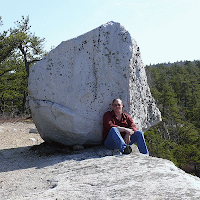 In September of 1609, Henry Hudson and his crew sailed up the Hudson River and saw a very different landscape than that which we see today. Sure the river's in pretty much the same place, the cliffs of the Palisades are still there, and we still have forests, meadows, and marshes adjoining the river but many other things would be unrecognizable to Henry Hudson today. One of those is Manhattan Island.
In September of 1609, Henry Hudson and his crew sailed up the Hudson River and saw a very different landscape than that which we see today. Sure the river's in pretty much the same place, the cliffs of the Palisades are still there, and we still have forests, meadows, and marshes adjoining the river but many other things would be unrecognizable to Henry Hudson today. One of those is Manhattan Island.Mannahatta: A Natural History of New York City
Sanderson writes:
Mannahatta had more ecological communities per acre than Yellowstone, more native plant species per acre than Yosemite, and more birds than the Great Smokey Mountains National Park. Mannahatta housed wolves, black bears, mountain lions, beavers, mink, and river otters; whales porpoises seals, and the occassional sea turtle visited its harbor. Millions of birds of more than a hundred and fifty different species flew over the island annually on transcontinental migratory pathways; millions of fish - shad, herring, trout, sturgeon, and eel - swam past the island up the Hudson River and in its streams during annual rites of spring.Quite a difference from the concrete jungle which exists today.
The book is great. I especially liked the chapter on the Lenape - the original inhabitants of the island. It's the type of book you can skim and just enjoy the pictures - especially the before and after images like that above - or delve into tremendous detail on Muir webs (ecological relationships between environments, flora, and fauna), geographic information systems (GIS), and details on the creation of the Mannahatta database.
Most libraries in the Hudson Valley should have this book although it's currently very reasonably priced ($26) on Amazon. Highly recommended.
By the way, there's also a neat companion website at http://themannahattaproject.org/ with an interactive map were you can see what any part of Manhattan looked like prior in 1609 along with interesting information for educators.



No comments:
Post a Comment